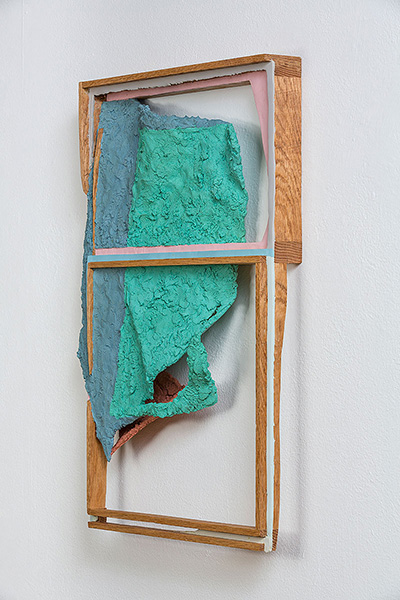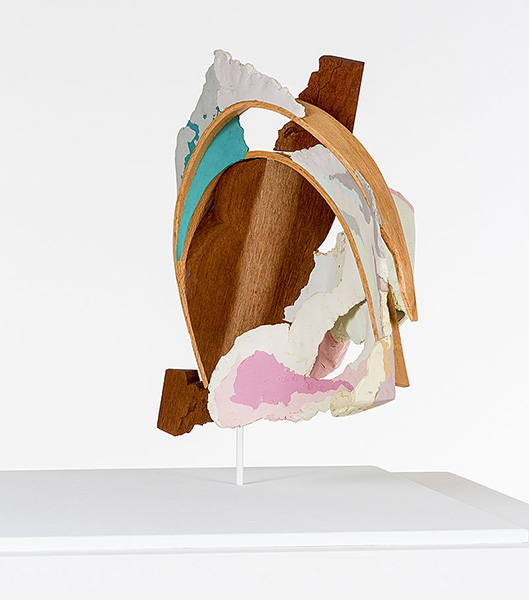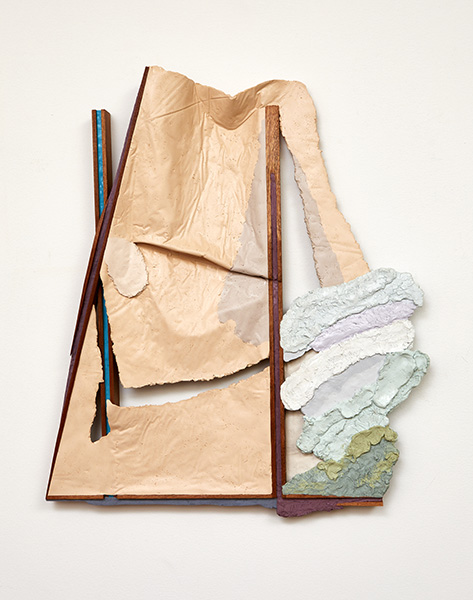
June 23, 2017
Christian Maychack @ Gregory Lind
by David M. Roth
Christian Maychack makes sculpture that insistently references painting. He invokes its conventions and material hierarchies, then violates them, exercising an intuitive, process-based approach that invests his objects with a quality too seldom seen in abstract art: humor. His current exhibition, Reciprocals, is a blend of precision joinery and detritus aesthetics rendered in Play-Doh hues and textures.
In this, as in the exhibition preceding it, split states (2014), Maychack jams pigment-infused epoxy clay into wood enclosures, interleaving amorphous shapes with hard-edged geometric forms to suggest windows invaded by mutant growths. These he bisects and appends with other shapes, creating windows-within-windows (Pink Dropout), while making other works like Compound Flat # 59 and Compound Flat # 60 that look as if fabric swatches had blown in from outdoors and attached themselves to the frames. In these, the artist makes deft use of negative space: in the places where there is no clay, all we see are the white walls on which the works are mounted, readable as either grounds or voids or, perhaps, both. The humor is deadpan.
In other works, like the pole-mounted, Compound Flat 65 and Compound Flat 64, it’s joyous and flamboyant. In the first, thin strips of curved wood interrupt a slab of carved mahogany that contains and suspends wafer-thin volumes of color. In the second, similar multi-colored shapes float wing-like from a block of wood, majestic and brittle.
This multi-planar approach harks back to Cubism and its many offshoots, but also draws playful present-tense comparisons to sculptor Robert Hudson, the great aggregator of metal detritus who Maychack (a resident of New York) could have encountered during his student days in San Francisco.
Links to contemporary painting also abound. Looking at Load Correction, for example, where a pile-up of colored squiggles rests incongruously at the far edge of interlocked frames, I thought of Mary Heilmann and the wavy shapes and juicy textures she used in Surfing on Acid (2005). I also thought, more generally, of Jonathan Lasker and his extreme mash-ups of thick and thin paint in relation to Maychack’s incongruous juxtaposition of earthen-like materials and geometric forms.
The first time I saw Maychack’s work in 2011 (Uncertain Spaces) the artist was working epoxy clay into the crevices of wicker basketry. The mixture, as he then formulated it, looked more like cement than anything you could paint with; but he soon did just that, injecting it with hot and cool colors, fusing it to solid frames, rubbing it into the grain of the wood itself, and then sanding it to a marbleized state. That treatment brought to the surface swirling patterns that have since been replaced by expanses of solid color, which the artist sands smooth or leaves as-is, coarsely textured. This lends the work a provisional character, suggesting an alliance between found and fabricated, natural and man-made forms. While his sculptures are exquisitely balanced, they can also feel — like Hudson’s gyroscopic constructions — slightly out-of-whack, as if they might fly apart and recombine into something else.
Such displays of sure-footed mutability and material invention have set Maychack on a solid upward course, advancing painting and sculpture in ways that call on art history, but without necessarily repeating it or following too closely on the heels anyone else’s innovations save his own.



